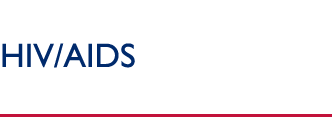Prevention of Mother-to-Child Transmission of HIV
One of the tragic consequences of the HIV/AIDS pandemic is mother-to-child transmission (MTCT) of HIV. Transmission of the virus can occur during pregnancy, at the time of delivery, or through breastfeeding. Approximately 630,000 babies became infected with HIV last year and Africa bears 90 percent of this burden. Worldwide, more than four million children are estimated to have died from AIDS, primarily contracted through MTCT.
The best way to avoid MTCT is to prevent HIV infection among women of reproductive age. However, for the close to 20 million women already infected, the U.S. Agency for International Development is committed to helping reduce the likelihood of transmitting the virus to their infants.
USAID has been working to prevent MTCT since 1999. These programs expanded significantly with the announcement of President Bush's International Mother and Child HIV Prevention Initiative in June of 2002. The primary objectives of this plan are expanding voluntary HIV counseling and testing for pregnant women, administering single dose antiretroviral drugs to mother and infant, supporting safe infant feeding options, and starting women and their spouses on full antiretroviral therapy, where capacity of health care systems allow.
Six months after the announcement of this initiative, President Bush reinforced his dedication to combating global HIV/AIDS with the President's Emergency Plan for AIDS Relief. The Emergency Plan aims to support treatment for at least two million people living with HIV/AIDS, prevent seven million new infections, and support care for 10 million people infected with and affected by HIV, including orphans and vulnerable children.
What are USAID's primary MTCT interventions?
Improvement of antenatal services — USAID-supported sites are improving antenatal services — including voluntary counseling and testing — by training health workers and counselors, upgrading medical facilities, and providing HIV test kits. Community outreach workers are integral to reaching women and their families in areas underserved by traditional medical facilities.
Short-course antiretroviral prophylaxis for HIV-infected
pregnant women — USAID currently funds the provision of antiretroviral drugs to reduce mother-to-child transmission, which studies have shown can reduce infection rates in newborn babies by 20 to 50 percent.
Support for safe infant feeding practices — Safe infant feeding is one of the most complex aspects of MTCT prevention. In most developing countries, the majority of women do not know their HIV status and safe, affordable, and culturally acceptable alternatives to breastfeeding are limited. USAID funded MTCT programs provide HIV-positive women with information and support to help them make informed decisions about how to feed their babies.
Strengthening health, family planning, and safe
motherhood programs — Over the past 20 years USAID family planning programs have strengthened health systems to support safe motherhood. This includes improving obstetrical practices in order to reduce MTCT during delivery. Additionally, health counseling and safe, effective contraception can help women practice safer sex and prevent unintended pregnancies, potentially reducing the number of HIV-infected children.
What is MTCT Plus?
Existing MTCT programs may provide a good foundation for the wider introduction of care and treatment. MTCT Plus programs strive to expand focus from the health of the infant to also include mother, father, and siblings — thereby maintaining the family unit. This approach is advantageous because clients are already identified and at least a basic level of health care infrastructure exists. MTCT Plus programs should include nutritional, medical, and psychosocial support as well as antiretroviral therapy for mothers and family members, where clinically appropriate.
USAID has programs to prevent mother-to-child transmission of HIV in 26 countries in every region of the world: Bolivia, Cambodia, Democratic Republic of the Congo, El Salvador, Eritrea, Ethiopia, Ghana, Guinea, Guyana, Haiti, Indonesia, Kenya, Malawi, Mozambique, Namibia, Nigeria, Peru, Rwanda, Senegal, South Africa, Tanzania, Russia, Uganda, Ukraine, Zambia, and Zimbabwe.
July 2005
USAID Country
Programs: Prevention of Mother-to-Child Transmission of
HIV
In Focus: Women and AIDS - Prevention of Mother-to-Child HIV Transmission
» |


